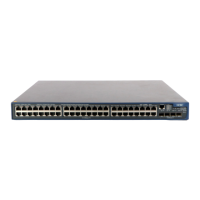1-30
Description
Use the traffic-remark-vlanid command to enable VLAN mapping and set the target VLAN ID for
packets matching specific ACL rules.
Use the undo traffic-remark-vlanid command to disable VLAN mapping for packets matching specific
ACL rules.
Related commands: display qos-interface traffic-remark-vlanid.
Examples
# Enable VLAN mapping on Ethernet 1/0/1 to map the VLAN IDs of the inbound packets sourced from
VLAN 5 to VLAN ID 1001.
<Sysname> system-view
System View: return to User View with Ctrl+Z.
[Sysname] acl number 4000
[Sysname-acl-ethernetframe-4000] rule permit source 5
[Sysname-acl-ethernetframe-4000] quit
[Sysname] interface Ethernet 1/0/1
[Sysname-Ethernet1/0/1] traffic-remark-vlanid inbound link-group 4000 remark-vlan 1001
traffic-statistic
Syntax
traffic-statistic inbound acl-rule
undo traffic-statistic inbound acl-rule
View
Ethernet port view
Parameters
inbound: Enables traffic accounting for the inbound packets.
acl-rule: ACL rules to be applied for traffic classification. This argument can be the combination of
multiple ACLs. For more information about this argument, refer to
Table 1-4 and Table 1-5. Note that the
ACL rules referenced must be those defined with the permit keyword.
Description
Use the traffic-statistic command to enable traffic accounting for packets matching specific ACL rules.
Use the undo traffic-statistic command to disable traffic accounting.
Related commands: display qos-interface traffic-statistic, reset traffic-statistic.
Examples
# Enable traffic accounting on Ethernet 1/0/1 for the inbound packets sourced from the IP network
segment 1.1.1.0/24.
<Sysname> system-view
System View: return to User View with Ctrl+Z.
[Sysname] acl number 2000
[Sysname-acl-basic-2000] rule permit source 1.1.1.0 0.0.0.255

